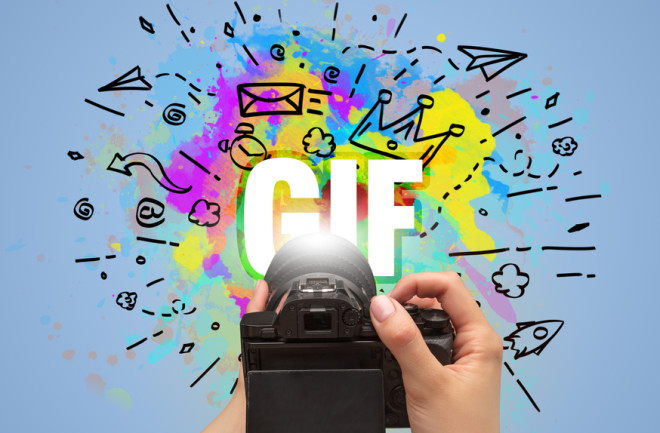Oh, GIFs, how could we ever capture all of our human emotions without them? After all, nothing truly expresses our excitement on Friday night like a GIF of Beyoncé dancing.
Of course, they’re also there for encapsulating tougher emotions light-heartedly, like our midday breakdowns that are conveniently represented by GIFs of an adorable baby or pet throwing a temper tantrum.
What Is a GIF?
The best part about these GIFs is the instant commentary and reactions that they provide without having to type out a single word. The graphics interchange format, which is what GIF stands for, is an easy way to communicate in the 21st century, making it a popular go-to worldwide.
While animated GIFs may have started peaking in 2013, the history of GIFs traces back to over 35 years ago. Here’s the real reason GIFs were invented and how, over three decades later, they became the popular and hilarious internet sensation that completes our favorite group chats today.
Read More: What Is a Social Media Cleanse?
The Real Reason GIFs Were Invented
To understand why the GIF was created, we must first delve into the dark ages of the World Wide Web. Before the public gained full access to the Web, which contains all the text, images, video clips, animations and essentially, everything we need, there were online service companies that fulfilled our desires.
CompuServe emerged as a leader of online services in America in 1979 and offered users the ability to access email and transfer files with hourly subscriptions, per WIRED.
Yet, the problems of speed and space kept creeping up, especially as users tried to transfer colorful images that were too large for the computer systems at the time to handle. Computer scientist Stephen Wilhite and his team at CompuServe were tasked to solve this issue by compressing images while still retaining their color and sharpness, according to Smithsonian Magazine. But what they didn’t know then was that by doing so, they would create an image format that would live on for decades, now known as the GIF.
In 1987, Wilhite created the graphics interchange format by using a compression algorithm. He got the order to do so from CompuServe executive Alexander Trevor.
“We didn’t want to have to put up images in 79 different formats,” said Trevor on the pressing desire for a universal graphics format for CompuServe in the 1980s, according to Fast Company. At the time, the GIF quickly became the fastest way to hold and transfer a slideshow of multiple still images in color. While the images weren’t animated like they are today, it was still possible to weave the still images together to tell a story, similar to a digital flipbook.
Read More: OMG! The History of Emojis May Surprise You
But how did GIF exactly get to the exciting animation loop stage that makes it a viral sensation today? Well, the rave reviews of GIF’s abilities quickly spread, and soon enough, web developers started utilizing GIFs as a crucial part of their site-building processes.
In the 1990s, news surfaced that the compression algorithm Wilhite had used to create GIFs, called Lempel-Ziv-Welch, had already been patented by a company called Unisys, per Marketplace.org. Because Unisys wanted to charge a fee for any use of GIFs, a full-on patent war broke out that put a temporary halt on the fast-growing GIF and led developers to lean into other file formats like PNG. That is until GIFs made their glorious return to fame in the early 2000s.
Read More: Why We Can’t Stop Talking About ‘Karen’ — and Why Labels and Memes Speak to Us
The Evolution of GIFs
By the time the patents on GIFs had expired and the patent war had ceased, it was already 2004, and the Web had completely evolved. With the rise of early 2000s social media platforms like Facebook, Myspace and YouTube, and the smartphone craze, GIFs started to make a comeback online.
New editing software like Photoshop also made it easier to transform the GIF from a collection of still images to a looped video, per Vox. This led to the quick creation and rise of all the different types of GIFs we are familiar with today, including video, animation and sticker GIFs.
Read More: Social Media May Be Changing The Way You Communicate
Reaction GIFs, which were primarily video-based, soon took over instant messaging and social media apps. The video GIFs were often quick, funny clips from a movie or T.V. scene. These GIFs' instant delivery and relatability made them even more popular. For instance, NBC’s famous T.V. show “Friends” created multiple GIFs based on favorite scenes and lines from characters on the show on the GIPHY Channel, which contains a database of GIFs. Though the series finale aired in 2004, GIFs from the show continue to live on and have generated nearly 1 billion views, according to Giflytics.
In 2013, as GIFs reached their prime, Stephen Wilhite was recognized for his achievement in creating the GIF and presented with a Lifetime Achievement Webby Award by the International Academy of Digital Arts and Sciences. According to The New York Times, Wilhite also put a rest to the ongoing debate about GIF’s pronunciation at the time, which he confirmed should sound like ‘JIF,’ with a soft ‘G’ when said aloud.
Today, Wilhite’s creation has withstood over three decades of changes. While the future of GIFs remains unclear, the looping image format remains relevant in our group chats and on social media.
Read More: How to Beat Social Media Algorithms

